I. Framing The Issue: What Do We Know?
Multifamily properties typically are defined as properties containing five or more dwelling units. Since 1995, researchers have examined extensively multifamily properties containing less than 50 units. Some of this work was provoked by a widely held perception within the policy community that this segment of the market is underserved, or perhaps inappropriately served, by capital sources. Many experts bemoan the permanent loss from the housing stock over the last decade of hundreds of thousands of these units. The purpose of this article is to examine the “capital problem,” one of the principal causes of this loss, and to initiate a dialogue to help resolve the challenges faced by this market segment.
The 5- to 49-unit multifamily market segment, popularized by Fannie Mae’s 5-50 Small Loan Program, represents more than 6 million housing units. This accounts for 37% of the multifamily stock and 6% of the total housing stock in the United States (see Figure 1).
Over half of these units, or 3.6% of the nation’s housing stock, consist of 5- to 20-unit properties. These units are 77% individually owned; tend to be older than other apartments (see Figure 2); and are financed predominantly with adjustable rate mortgages. Little is known about the 23% that are not individually owned; however, a review of the public filings of REITs shows typically that these are not held by institutions, and so are probably held in partnerships or trusts. Twenty to 49-unit multifamily properties comprise 2.4% of the nation’s housing stock and could be institutionally owned if the units were niche market-oriented.
II. What Appears To Be The Capital Problem?
The explosion of securitized multifamily lending seems to have bypassed the 5- to 49-unit sector of the multifamily market. Most securitized lending is fixed rate, non-recourse, and intermediate to long-term (i.e., 10 to 30 years). By comparison, various studies (Schnare, Hamilton Securities’ 1996 study, New England FHLBB study) show that smaller multifamily property financing typically is variable rate, recourse, and shorter-term maturity (5 years). Also, Fannie Mae data indicate that 5-50 loans account for less than 5% (around $3 billion) of loans in a $60+ billion portfolio.
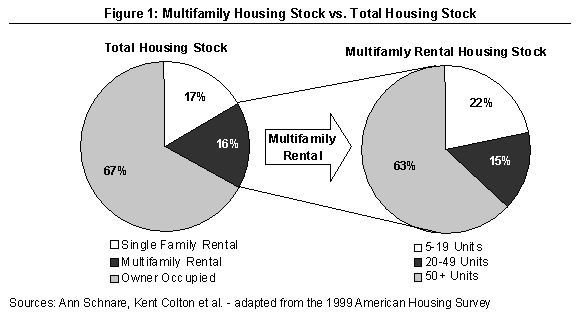
Many experts, observing that the small multifamily market receives no benefit from lower rate securitized structures, believe this market to be underserved. In addition, the S&L debacle and extensive bank consolidation over the last decade have removed this market’s primary communitybased financing source. Therefore, to compensate, the industry has pushed the FHA to make insured loans in amounts under $1 million (before it could get its act together to provide above $1 million loans efficiently!); provided substantial GSE housing goal incentives (double credits) for Fannie Mae and Freddie Mac to finance small multifamily lending; and lobbied the Federal Home Loan Bank system to expand its mortgage partnerships.
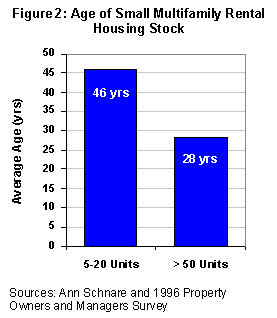
There are, however, strong arguments that these incentives never will work by themselves. Various studies conclude that there are traditional lending reasons why capital for the 5- to 49-unit sector is, and should be, more expensive. The more obvious reasons include:
- The cost of due diligence. To ignore the income property nature of this sector is to commit the banking equivalent of a special reserve suicide. Investors and lenders must possess an income property valuation, knowledge of environmental issues, and an appreciation for the property’s physical condition, all of which cost money to obtain. Streamlining can improve cost effectiveness, but never will make due diligence requirements for this segment of the market cheap on a relative basis.
- The perception (and perhaps reality) of higher losses. Recent studies indicate that historically the severity of losses in small loans is greater. Recent reports show that loans of under $2 million have a 17.34% loss rate compared to a 4.6% rate for loans of over $10 million (UNC/ACLI, June 2001). This is consistent intuitively with the first problem of transaction costs. Most loan recovery costs are fixed, and state and federal laws have created lengthy delays in foreclosure and bankruptcy proceedings.
- The location and use of small multifamily housing differs from that of other multifamily properties. These differences make resale value difficult to judge. Issues of overcrowding, code violations, tenant tenure, collection practices, lack of documentation, and comparability problems associated with non-professional management render most sophisticated analysis meaningless. Hence, without a managed, but expensive, credible database, there is not much guidance other than the instinc0t and market knowledge of the lender.
A few institutions, most notably South Shore Bank and Community Investment Corp. in Chicago, and Community Preservation Corp. in New York, have made noble efforts in communitybased small multifamily lending. These three groups are highly focused, but have not aspired yet to be nationalized or securitized, and are run by people who would not be transplantable easily. One national experiment worth mentioning is Column Financial, which is part of Credit Suisse First Boston. Its small loan program has addressed, through extensive use of a web-based process and local appraisers, many of the issues outlined above, and makes loans that are securitizable.
However, even with spreads that are well in excess of large loans, the enormous costs of getting rating agency and B-piece buyer approvals make it unlikely that this segment represents more than a niche. The limited long-term performance history for these loans further compounds the challenges faced by this market segment, and suggests that securitized lending in this segment is still an experiment, albeit one worth watching.
III. If Not Debt Capital, Could It Be Equity?
Issues of individual ownership, aging properties, overcrowding, and urban locations cannot be addressed simply by lowering transaction costs and by streamlining the debt process. The smaller multifamily market cries out for a reliable equity solution. To preserve these units, the industry must facilitate the transfer of ownership from individual to institutional. This would produce enough scale to obtain professional management and more flexible capital, and expend the dollars necessary to bring this much needed stock into the 21st century while maintaining its affordability for the next generation of immigrants and urban dwellers. The real answer to the dilemma is to create a new type of equity vehicle: one which is congressionally chartered, that works on a large scale, and mingles private capital with local, state, and federal resources — one that essentially can be called a small multifamily REIT, or S-REIT.
Outlined below are the basic components of this proposed S-REIT (see Figure 3). It must:
- Be able to exchange partnership units for 5- to 49-unit properties tax-free.
- Be chartered so it is exempt from recording taxes, and SEC and state registration costs, and have the ability to create a tax-exempt bond issuing capability.
- Provide an assured cash flow to the existing owner along with potential equity appreciation rights.
- Use the best local professional management, whether for-profit or non-profit.
- Receive local government tax abatement support for its activities so that the cash flow savings can be reinvested in the properties.
- Receive preference for other federal resources such as the low-income housing tax credit, HOME, and CDBG.
- Have financing (as well as federal subsidy allocations) available at a corporate level so as to match assets and liabilities without the costs of single asset financing.
IV. Can The S-REIT Model Work?
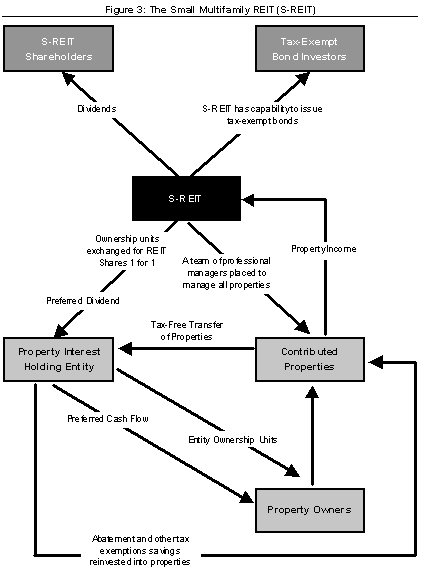 Modeling Methodology
Modeling Methodology
To test the ideas above, we prepared a model of three small multifamily properties and aggregated them to a scale that can be duplicated in a major urban area.
First, we selected three typical small multifamily properties containing a total of 120 units (two properties with 36 units each and one property with 48 units), and constructed an income and expense statement for each property. We included replacement reserves, capital expenditures, leverage, and cost of debt. To create scale, a prerequisite for the proposed S-REIT, we consolidated the three properties and applied a multiple of ten (1200 units). We also broke out expenses per unit.
Second, we adjusted per unit costs to reflect economies of scale and functions taken over by the S-REIT, and added additional per unit costs that would reflect the costs associated with organizing the S-REIT (see Table 1). Also, we assumed a 50% property tax abatement to encourage reinvestment. These adjusted, per unit costs were then multiplied by the number of units in the proposed properties portfolio and used to complete a hypothetical S-REIT income statement.
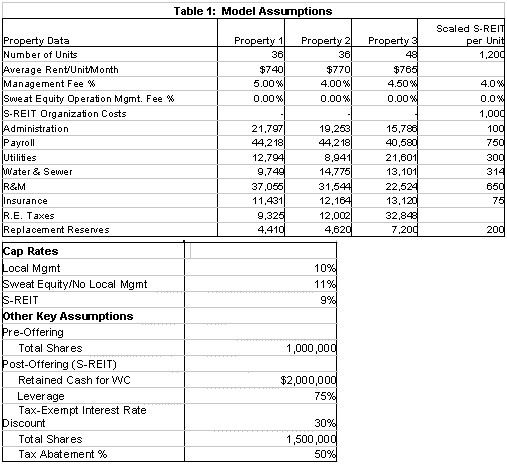
Then two different scenarios were analyzed to address the effects on small multifamily properties of often being owner managed and maintained, or what many call “sweat equity operations.” One model assumed local property management, while the other assumed a sweat equity operation. The principal difference between the two models reflects the assumption that the sweat equity option has no management fees and a higher capitalization rate.
Next we applied cap rates to each model to arrive at a valuation for the portfolios; we used a 9% cap rate for the S-REIT model, 10% for the local management model, and 11% for the sweat equity model. The differing cap rates reflect the relative operations risk. This allowed us to compare returns on invested capital (ROIC) after applying different leverage levels to the S-REIT structure and to the individual ownership structure. For purposes of this analysis, the individual property owners’ invested capital is assumed to be their equity position based on the difference between valuation and assumed debt.
The models assume that each property owner would swap their property with the S-REIT for an allocation of partnership units (or shares) based on their equity positions in their respective properties. We also assume, to capitalize the S-REIT, that the S-REIT would issue 500,000 additional shares to institutional investors at the corresponding per share valuation. Once new professional management is in place and over $900 per unit in capital improvements is reinvested, the S-REIT would issue tax-exempt bonds at a lower interest rate than the original weighted average interest rate and at a slightly higher loan-to-value (LTV) ratio. These proceeds would then be allocated to redemption of owner interests (if desired) up to 50% of the original equity basis and $2 million for working capital. This provides a measure of capital for growth if the model is successful, and the owners are happy to take ongoing cash flow in lieu of cash.
All assumptions are presented in Table 1, above, and all results are presented in Table 2, below. Detailed calculations for each scenario are presented in appendix Table 3 (PDF) and Table 4. (PDF)
V. S-REIT Verdict–It Works, In Theory…
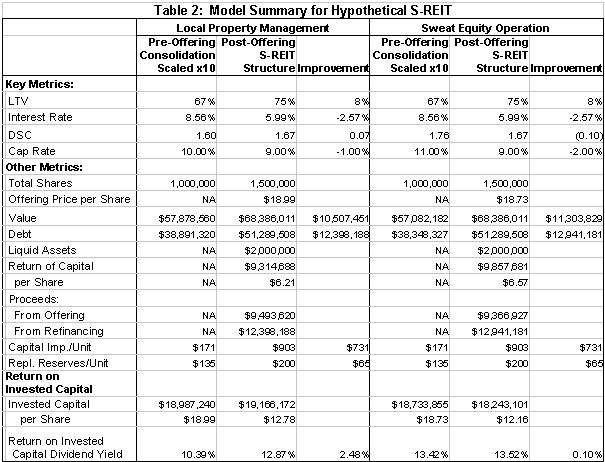
While the assumptions in our models certainly can be debated, they are not unreasonable:
- A 50% property tax abatement is provided in return for reinvestment.
- The reinvestment that is needed is about $903 per unit.
- The higher costs of institutional ownership are offset, to some extent, by the lower costs of insurance and procurement.
- Higher leverage is obtained at significantly lower debt costs.
The models presented here suggest that it is possible to maintain total expenses and still offer a reasonably attractive return to the existing owners, and a return to the S-REIT shareholders. While this outcome appears achievable, ensuring this with housing vouchers for the tenants who “stick” with their units for a period of time would provide more effective guarantees. However, for the S-REIT model to work in practice, the private and non-profit sectors must provide the requisite capital and management.
VI. Challenge And Summary
What if we received a congressional charter, could raise $50 to $100 million in below-market equity financing from private sources, and got a specific allocation of “sticky vouchers” for the first 3 years? Could we then pick a few target cities and develop the infrastructure and local political support to test seriously the hypothesis that owners will swap, cities will provide tax abatements in return for reinvestment, rehab will occur, and tenants will remain at affordable rents? If so, and it actually works, we must then institute this on a scale that can ultimately preserve millions of badly needed housing units.
Intractable problems often take ingenuity to solve. As indicated, there are several institutions taking a creative approach to small multifamily project debt financing. However, there is a real need to consider both the long-term sustainability of smaller properties in the capital markets and procurement systems that reward size, scale, and professionalism. To explore options and garner support, let’s take the idea of the S-REIT and further analyze it with small property owner focus groups to determine under what circumstances small property owners would consider a property transfer. Then let’s pick a few cities with large concentrations of small multifamily properties to see whether they will lend support and provide the tax abatement. Let’s also seek confirmation and additional input by asking our readers if it is an equity solution and a managed, credible database that are needed — not just another white paper about streamlining the loan process.
Acknowledgements
I owe a debt of gratitude to Nic Retsinas for engaging me in the policy research field and then gently nudging me to document my thoughts. Rahul Patel, on my staff, ably developed the models and then the accompanying graphs and tables with data support from Eric Belsky and Mark Duda of the Harvard Joint Center for Housing Studies.


Commentary
Why Do Small Multifamily Properties Bedevil Us?
November 1, 2001